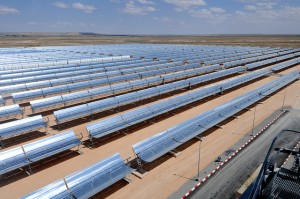Forbes
Christopher Coats, Contributor
Continuing its push for energy diversification, Morocco announced that it had completed financing for two large-scale solar projects assisting in the country’s renewable energy goals.
According to local media reports, the Moroccan Agency for Solar Energy (MASEN) announced that the NOOR II and III solar centers, producing 200 MW and 150MW, respectively, would be financed through a debt/equity ratio of 80/20. The debt will be financed by MASEN and guaranteed by an array of international lenders, including the African Development Bank, French Development Agency, Clean Technology Fund, European Commission, European Investment Bank, Kreditanstalt fur Wiederaufbau and the International Bank.
The projects, estimated to cost $2 billion, are a part of a broader solar strategy that aims to produce 14 percent of the country’s overall energy by 2020, according to the report. The financing development appears to back up the country’s earlier claims that Rabat would not need assistance from outside development partners to pursue its renewable goals.
In recent years, Morocco has worked to reduce its dependence on foreign sources through the development of domestic projects, including exploring newly found traditional reserves and shale projects. However, the state’s embrace of solar and wind has become a pillar of the country’s energy policy.
This is not to say that Morocco’s diversification push is free of traditional hydrocarbons. Heavily dependent on energy imports to meet its growing demand, Morocco has spent the last decade exploring new options to help reduce costly oil and coal imports, including supporting new exploration and production efforts, as well as renewable alternatives. In addition to allowing access to a greater variety of global gas prices, Morocco’s LNG plans would help reach its diversification goals by 2020. According to The National, the country hopes to provide 42 percent of its energy needs with renewable energy options by that year, with the remaining coming from fewer imports and a burgeoning domestic production sector.
Last year, the country’s political leadership reinforced its interest in pursuing offshore potential, including permits for Australia’s Woodside Petroleum. Late last year, it was reported that after modest interest for much of the last decade, a number of larger oil and gas firms have arrived in Morocco in pursuit of the country’s mainly offshore potential. Joining smaller operators like San Leon Energy and Longreach Oil and Gas, energy majors have begun targeting the country’s potential reserves with more than 10 wells planned over the next year, according to a Bloomberg report – more than twice what the country has seen over the last ten years. Since January, BP, Chevron and Cairn have all announced new projects or buy-ins to existing efforts, despite the country’s lackluster history of viable oil and gas discoveries.








